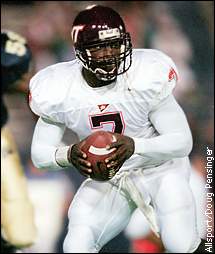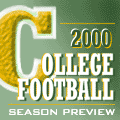| | By Bill Doherty
Special to ESPN.com
As his team prepared for its date with Virginia Tech in last January's national championship game, Florida State coach Bobby Bowden told anyone who would listen that he had seen the future of quarterbacks and his name was Michael Vick.
Nothing he saw in the Sugar Bowl changed his mind. "He's the next step in the (evolutionary) chain at the quarterback position," said Bowden. "In 10 years, lots of colleges and pro teams will have super athletes like Vick playing quarterback."
|  | | Michael Vick threw for over 2,000 yards and averaged 5.4 yards a carry running the ball last season. |
Virginia Tech coach Frank Beamer agrees. "We want to make it a guessing game," said Beamer. "We want people to think that Michael Vick is staying in the pocket and then get him outside. Or have them think he's going outside and keep him in the pocket."
In today's college football, more and more teams are going to a spread offense to make it more of a guessing game for the attack-style defenses that Beamer and Bowden play. For rebuilding programs, like Clemson and Oklahoma this time last season, it's the quickest fix – spread the opposition out and hope to prevail in the individual battles.
Call it the great equalizer. Look around college football and more and more teams will be going to the spread, college football's equivalent of the fast breaking style that has been so successful for Kentucky hoops in the 1990s. N.C. State, with former BYU assistant Norm Chow running the offense, will spread things out. Ditto Texas Tech. Heck, even a dinosaur like Lou Holtz is tinkering with one-back, multiple receiver sets at South Carolina.
"College football, in some ways, has become like college basketball," said Notre Dame coach Bob Davie. "It's a matchup game. There are so many schemes available to get players isolated. And with rush ends getting more and more athletic, quarterbacks have to be more nimble than ever to succeed in today's game."
Recent NFL drafts don't always reflect that trend. In the 1998 NFL draft, the first two quarterbacks taken were Peyton Manning and Ryan Leaf, two old school types (read: big, tall, strong guys who stand in the pocket and fire the football). Then in 1999, an old school QB (Kentucky's Tim Couch) went first and then came a run of more mobile guys in Donovan McNabb (Eagles), Akili Smith (Bengals), Cade McNown (Bears) and Daunte Culpepper (Vikings). All five will start this season as their team's No.1 guys. Last spring, the only quarterback to be drafted in the first round was Marshall's Chad Pennington, who is more of a dropback passer.
"The bottom line, whether it's college or pro football, is that you need a lot of elements to make a successful quarterback," said Philadelphia Eagles coach Andy Reid. "In our case, Donovan McNabb had to learn the base offense last year and that's a lot of stuff. Then we gradually fed him the new stuff. This offseason, he's been fed even more stuff. You need to be smart, mature, able to make quick reads, able to digest lots of information to succeed as an NFL quarterback."
|
“ |
The bottom line, whether it's college or pro football, is you need a lot of elements to make a successful quarterback. ” |
|
|
— Philadelphia Eagles head coach Andy Reid |
But with increasing numbers of college teams going to basketball-style offenses, their quarterbacks – or point guards on the field – are coming in all different shapes and sizes. Basically, there is no prototype college quarterback anymore. They run the gamut from guys that can beat you with their arms and their legs (Vick, Georgia's Quincy Carter, Washington's Marques Tuiasosopo) to guys who perfectly fit their system and are winners (Nebraska's Eric Crouch, Purdue's Drew Brees) to the old-school, dropback pocket passers (Michigan's Drew Henson, Florida State's Chris Weinke, USC's Carson Palmer). All are successful in their own way.
"What type of quarterback works for you depends on your system, whether it's college or pro ball," says Reid. "Look at Donovan McNabb and Steve McNair. Both are pretty much the exact same size, but different things are asked of them. Tennessee runs a ball-control, run-first offense with Eddie George and we're in Year Two of installing our West Coast offense, which is a pass-first attack."
The recently released NFL Scouting Index of top five pro prospects at quarterback (seniors only) supports Reid's different strokes for different folks theory: 1, Purdue's Drew Brees (6.20 rating on a 1-9 scale); 2, Oklahoma's Josh Heupel (5.80); 3, Iowa State's Sage Rosenfels (5.80); 4, Idaho State's Shane Griggs (5.5); and 5, Florida State's Chris Weinke (5.5). Of the five, only Brees and Griggs are mobile types. Both run sub-4.7 in the 40. Brees, Heupel and Weinke play in wide-open, spread-'em-out offenses. Rosenfels (6-4, 217), who threw for 1,781 yards and 10 TDs in 1999, will take to the friendly skies more often this fall, once new offensive coordinator Steve Loney installs his full package.
The mystery guest on that list is Griggs, who missed the last eight games of last season with a torn ACL and passed for a mere 339 yards and six TDs in 1999. Griggs has the size (6-4, 190), foot speed (4.7 in the 40) and arm strength to rate ahead of Weinke, the highly productive FSU quarterback who quided the Seminoles to last season's national championship, even though Griggs might not be the opening day starter for Idaho State. That's because Griggs' understudy last year, Kevin McCarthy, threw for 3,033 yards – including a 553-yard gem against Southern Utah – and a school-record 23 TDs last season. McCarthy is back at Idaho State, so NFL scouts would be advised to check the Bengals' depth chart before jetting off to Pocatello, Idaho.
With the suspect crop of senior passers and a talent-rich group of underclassmen in the college ranks in 2000, was it any wonder that when asked who would be the three quarterbacks to go highest in the 2001 NFL draft, one NFC scout hesitated and first asked, "Are we counting just seniors or both underclassmen and seniors?"
Informed that the pool included all quarterbacks regardless of class, the scout replied: "Then it would go Michael Vick, then Georgia's Quincy Carter and Purdue's Drew Brees. But if we're just counting seniors, it's Brees and then it's tough after that. It depends on your personal taste and the demands of your offense."
Bill Doherty covers the Big East for ESPN.com. | |
ALSO SEE
ESPN experts: Spotting the trends
|


